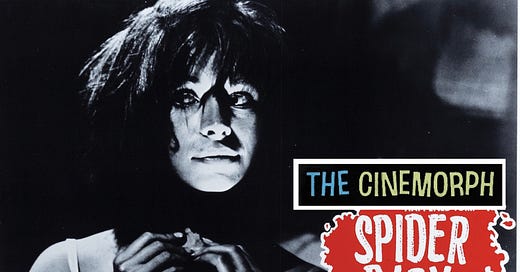The Glory That Is Spider Baby
Jack Hill's third film is better than it has any right to be, and hints to the classics to come.
“They’re not ordinary children.”
1967’s Spider Baby, or The Maddest Story Ever Told is a black and white super low budget horror comedy. Spider Baby is not one of those “so bad it’s good” films, like Glen Or Glenda or Dracula Vs. Frankenstein. To be sure, it’s insane. And it does have to be seen to be believed. But it’s better than you think. It’s technically solid, the performances are great and the whole endeavor turns out to be weird in a way that somehow holds together. This is most probably due to the surprising pedigree of its writer/director and stars.
Spider Baby tells the story of the Merrye children. I say children and not family because the parents are gone. The Merrye children, played by Jill Banner, Beverly Washburn and a very young Sid Haig, appear to be in their late teens, but possess the mentality of five or six-year-olds. Well, five or six-year-old homicidal cannibals. You get it. They are cared for by the family’s chauffeur, played by horror film titan Lon Chaney Jr. Chaney and the “children” are visited by two distant relatives, Uncle Peter and Aunt Emily, along with their lawyer and his secretary. Peter and Emily are here to see that the children, who are obviously developmentally disabled, are placed in an institution where they can get proper care.
This proposal goes over poorly. And things go downhill from there. For everyone.
Spider Baby was the third feature from Jack Hill. Jack Hill has a hell of a resume. His father Roland was the architect who designed Sleeping Beauty’s castle that sits at the center of Disneyland. He was a musician who played in the symphony orchestra that recorded the soundtrack for Dr. Zhivago. For extra money, he arranged music for burlesque performers and through that world became an acquaintance of Lenny Bruce. He attended UCLA film school and befriended Francis Ford Coppola, who he would follow over to American International Pictures. There, he would work for Roger Corman. Hill shot extra footage to pad out Corman’s The Terror, a film that starred Boris Karloff and a young Jack Nicholson. His first full length directorial effort was called Blood Bath. His second was something called Mondo Keyhole (you tell me).
Then came Spider Baby. Spider Baby is cheap, trashy, exploitative and off the rails nuts It’s also very good. Jill Banner was only 17 when she took on the titular role of the spider-obsessed Virginia. Banner underplays her character’s murderous psychosis, never losing the charm and innocence of Virginia’s psychological regression. “Don’t go anywhere, bug,” she casually quips to her tied-to-a-chair-and-about-to-be-killed uncle.
Lon Chaney Jr and Jill Banner in Spider Baby
The great Sid Haig gives a basically silent performance as Ralph. Part Harpo Marx, part Schlitzie, Haig made his screen debut in Hill’s student film The Host. Known to modern audiences as Capt. Spaulding in Rob Zombie’s House Of A Thousand Corpses and its sequel, The Devil’s Rejects, Haig’s filmography begins in 1962 and he seems to have worked nonstop until his death on 2019.
The heart and soul of Spider Baby belongs to Lon Chaney Jr. The horror legend has more than his share of over-the-top performances and questionable choices in his late period career, but he is in fine form in Spider Baby. The three children, spiritual descendants of Lenny from Of Mice And Men, the role that put him on the map, bring forth a well of emotion in the aging star. He is warm, cautious, subtle, caring, and seems all too aware that he is enabling horrors, but is helpless to stop. Sid Haig recounts the crew giving him a standing ovation after one monologue.
Spider Baby didn’t make much of an impact upon its release. It “premiered” at a drive-in in Fremont, Ohio on a triple bill with The Wizard Of Mars and Frankenstein Conquers The World. It did not die, however, and gained notoriety as a horror comedy classic. Today, on Rotten Tomatoes, it holds a rating of 94% fresh.
In an article about Hill posted on ArrowFilms.com by Beatrice Loayza called The Power Of The Collective: The Films Of Jack Hill, Hill is quoted as saying. “I feel quite fortunate that I worked in the low-budget sector because it meant I did not have to deal with committees who wanted to impose their ideas and prejudices on my material. I had a free hand – much more so than I would have had if I was working for the studios. As long as you put the elements in there that producers like [Roger] Corman knew they could sell, such as sex and violence, you could raise the picture a little bit higher than they expected and give the audience something intelligent to chew on.”
Hill followed Spider Baby with a women-in-prison melodrama called The Big Doll House. He would cast a newcomer named Pam Grier in the film, and together, they would form a professional partnership that lead to The Big Bird Cage, and then the classic one-two punch of Coffy and Foxy Brown.
Next...





